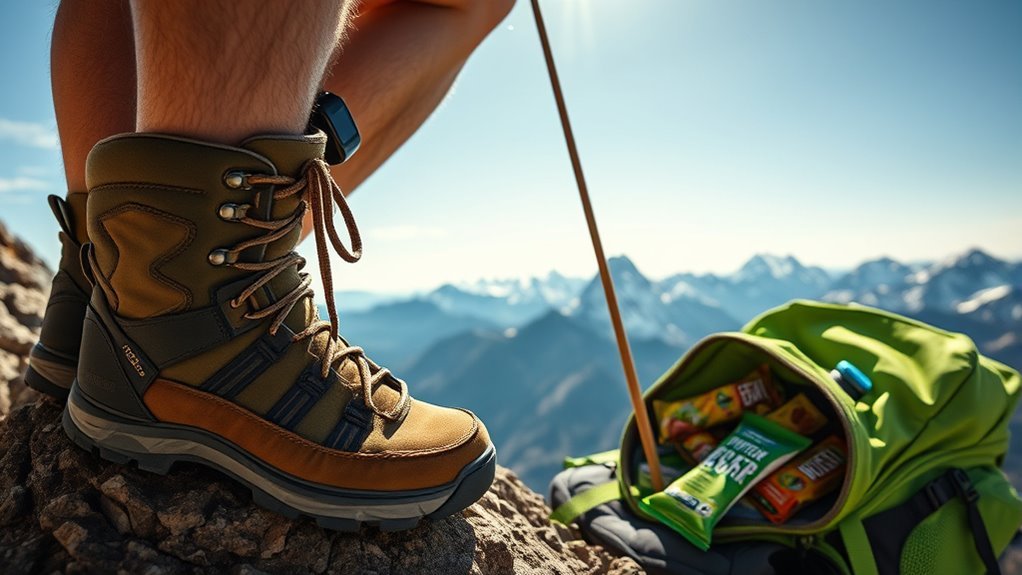To prepare physically for mountain climbing, assess your current fitness level. Focus on building cardiovascular endurance with activities like running or cycling. Incorporate strength training, emphasizing compound exercises and core stability. Don't forget flexibility and mobility exercises—dynamic stretches and yoga can help. Hiking and trail running will condition your body for steep terrains. Remember to stay hydrated and fuel your body with proper nutrition. There's more to explore about effective training techniques and mental preparation.
Assessing Your Current Fitness Level
Before you hit the trails, it's vital to assess your current fitness level. Understanding where you stand physically can make all the difference in your mountain climbing experience. Start by evaluating your endurance, strength, and flexibility. Do you find yourself winded after a short jog, or can you power through a longer hike? Take note of how many push-ups or squats you can manage; this'll help you gauge your strength for climbing.
Don't forget about flexibility, either. Can you touch your toes or hold a deep squat? These are essential for maneuvering over rocky terrain. You might also want to reflect on how often you engage in physical activity. If you're not regularly active, it's time to make a plan. Remember, climbing isn't just about reaching the peak; it's about enjoying the journey, so ensuring you're fit will help you embrace every moment along the way. Additionally, consider incorporating grip strength exercises into your routine to enhance your climbing performance significantly.
Building Cardiovascular Endurance
Once you have a clear picture of your fitness level, it's time to focus on building your cardiovascular endurance. This is essential for enjoying the freedom of mountain climbing. Start by incorporating activities like running, cycling, or swimming into your routine. Aim for at least 150 minutes of moderate aerobic activity each week.
You can also mix in high-intensity interval training (HIIT) to boost your stamina. This approach not only keeps things exciting but helps you push your limits. Gradually increase the duration and intensity of your workouts to challenge your body. Additionally, as your training progresses, you may notice improved oxygen delivery to muscles, which can significantly enhance your climbing performance.
Don't forget to listen to your body; rest when needed to prevent burnout or injury. As your endurance improves, you'll find yourself breathing easier on those steep trails, allowing you to immerse yourself in the beauty of the mountains. Embrace the journey toward better endurance—your climbing adventures will be all the more rewarding!
Strength Training for Climbers
While building cardiovascular endurance is essential, strength training is equally important for climbers. It's not just about hoisting your bodyweight; it's about mastering the rock and feeling the freedom of movement. Focus on compound exercises that engage multiple muscle groups, like deadlifts, squats, and bench presses. These workouts boost your overall strength and prepare you for the physical demands of climbing.
Incorporate pull-ups and rows to target your back and arm muscles, which are vital for gripping and pulling yourself up. Don't forget your core—planks and leg raises can enhance your stability and balance on the wall. Additionally, incorporating squats and deadlifts into your regimen will further develop your lower body and core strength, essential for maintaining stability on steep climbs.
Aim for two to three strength sessions a week, allowing your muscles to recover. Remember, it's about building the endurance to climb higher and conquer new challenges. Embrace the process, and you'll not only gain strength but also the freedom to tackle those stunning peaks.
Flexibility and Mobility Exercises
When you're preparing for mountain climbing, flexibility is just as essential as strength. It helps you move more freely and reduces the risk of injuries on the trail. Let's explore some recommended mobility exercises that can enhance your performance. Incorporating mobility training into your routine not only improves your range of motion but also serves as a foundation for overall athletic performance.
Importance of Flexibility
Flexibility plays an essential role in mountain climbing, as it enhances your range of motion and helps prevent injuries. When you're maneuvering rocky terrains or reaching for that next handhold, being flexible allows you to move freely and confidently. You won't be restricted by tight muscles or stiffness, which can hinder your performance and enjoyment. Improved flexibility also aids in muscle recovery, letting you bounce back quicker after a challenging climb. Embracing a flexible body means embracing the freedom to explore and enjoy the great outdoors without limitations. So, make flexibility a priority in your training routine, and you'll find that each climb becomes an exhilarating experience, allowing you to connect with nature in the most fluid way possible.
Recommended Mobility Exercises
Incorporating a variety of mobility exercises into your training can greatly enhance your climbing performance. Focus on dynamic stretches like leg swings and arm circles to increase your range of motion before hitting the rocks. Incorporate yoga poses, such as downward dog and pigeon pose, to improve flexibility and balance. Don't forget about foam rolling; it helps release tight muscles and increases blood flow. Additionally, try lunges and squats to strengthen your legs while improving hip mobility. Remember, the more fluid your movements, the more freedom you'll feel on the climb. Carving out time for these exercises not only prepares your body but also boosts your confidence, letting you embrace the adventure that awaits in the mountains.
Hiking and Trail Running for Specific Conditioning
As you prepare for mountain climbing, hiking and trail running can greatly enhance your specific conditioning. These activities mimic the varied terrain and elevation changes you'll face in the mountains, building the strength and endurance you need. Start by choosing trails that challenge you; steep inclines and rugged paths will engage your muscles and improve your stamina.
Trail running adds intensity to your workouts, pushing your cardiovascular limits and enhancing your agility. Try to incorporate intervals of faster running to simulate the bursts of effort needed during climbs.
Don't forget to focus on your footwork and balance—these are essential for traversing rocky terrains. As you build up your mileage, you'll develop the mental resilience to keep pushing through tougher conditions, giving you the freedom to explore new heights. Additionally, staying hydrated during these activities is crucial for maintaining your energy levels and preventing fatigue. Embrace each hike and run as a step towards conquering those mountain peaks!
Nutrition and Hydration Strategies
After honing your physical conditioning through hiking and trail running, it's time to focus on how to fuel your body for the demands of mountain climbing. Nutrition is your ally; pack high-energy snacks like nuts, dried fruits, and energy bars. They're easy to carry and offer quick bursts of energy when you need them most.
Stay hydrated! Water's essential for maintaining stamina, so drink regularly, even if you don't feel thirsty. Consider electrolyte drinks for longer climbs to replenish lost minerals. Monitoring urine color can also help you assess your hydration status during the climb.
Before your climb, eat a balanced meal with carbs, protein, and healthy fats—think whole grains, lean meats, and avocados. This'll give you sustained energy.
Don't forget to listen to your body; it knows what it needs. With the right nutrition and hydration strategies, you'll feel freer to conquer those peaks and savor every moment of your adventure.
Mental Preparation and Focus Techniques
While physical training is crucial, mental preparation can make or break your mountain climbing experience. To truly embrace the freedom of the mountains, you need to sharpen your focus and strengthen your mindset. Start by visualizing your climb—picture every step, the breathtaking views, and the exhilaration of reaching the summit. This mental rehearsal helps you build confidence and reduces anxiety.
Incorporate mindfulness techniques, like deep breathing or meditation, to cultivate calmness and clarity. When you're on the mountain, distractions can creep in; staying present is essential. Use positive affirmations to reinforce your belief in your abilities; remind yourself that you're capable and resilient. Additionally, embracing challenges can forge a stronger mindset and prepare you for the uncertainties of the climb.
Lastly, set realistic goals for each climb, focusing on the process rather than just the summit. Embracing each moment enhances your experience and fosters a sense of freedom. With the right mental tools, you can conquer any challenge the mountains present.
Frequently Asked Questions
What Gear Do I Need for Mountain Climbing Training?
For mountain climbing training, you'll need sturdy climbing shoes, a harness, a helmet, and chalk. Don't forget a good backpack, water bottles, and weather-appropriate clothing to guarantee your comfort and freedom during your adventures.
How Long Should My Training Last Before a Climb?
Your training shouldn't just be a fleeting moment; it should be a journey. Ideally, aim for at least 8 to 12 weeks of consistent preparation, allowing your body the freedom to build strength and endurance.
Can I Prepare for Climbing Without a Gym?
Absolutely, you can prepare for climbing without a gym! Focus on outdoor activities like hiking, bodyweight exercises, and strength training at home. Just get creative, embrace nature, and enjoy the freedom of movement.
What Common Injuries Should I Be Aware Of?
Climbing's like dancing on the edge of nature's thrill. You should watch for sprains, strains, and blisters. Understanding these common injuries helps you embrace the freedom of the mountains while keeping your body ready and resilient.
How Do I Find a Climbing Partner or Group?
To find a climbing partner or group, check local climbing gyms, online forums, or social media. Connecting with like-minded adventurers can lead to great partnerships, shared experiences, and unforgettable journeys in the mountains together.




